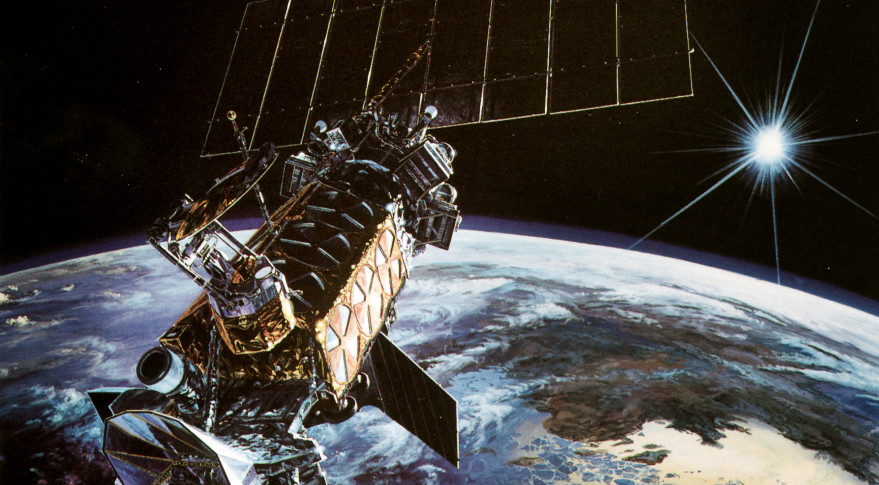ESA: U.S. Silence on Satellite Explosion No Cause for Alarm

PARIS — European governments have received no word from the U.S. Air Force in the month since the Feb. 3 debris-producing explosion aboard a military weather satellite in a heavily trafficked orbit but said they hadn't expected any.
These officials said nonetheless that if the Air Force's Joint Space Operations Center (JSpOC) had concluded that debris from the DMSP-F13 satellite's explosion placed a European satellite at risk, JSpOC likely would have sent out a notification in the days following the event.
The 20-year-old U.S. Air Force Defense Meteorological Satellite Program Flight 13 satellite exploded at about 830 kilometers in altitude in polar sun-synchronous orbit Feb. 3, producing a debris field numbering around 40 pieces that are large enough to be tracked. [Quiz: What Do You Know About Satellites?]
So far, the identified debris pieces have mostly stayed in the vicinity of the main body of the satellite. Debris experts say that if 40-plus pieces are trackable, it's safe to assume more than 100 pieces were created in the explosion.
That is a heavily used orbit for polar-orbiting weather satellites, with U.S. civil, European, Russian and Chinese spacecraft in orbit providing services similar to the mission of DMSP-F13.
Satellite-tracking analysts were the first to notice the event in the days and weeks following the explosion.
But the Air Force's silence until weeks after the event should not be considered abnormal or problematic, said Holger Krag, head of the European Space Agency's Space Debris Office, located at the agency's space operations center in Darmstadt, Germany.
Breaking space news, the latest updates on rocket launches, skywatching events and more!
"There has never been a policy of communicating on events like this, and no formal communications means exists for this kind of event," Krag said. "We feel we were always covered operationally given the much-appreciated warnings given to use [by JSpOC], even of classified objects."
ESA and several European governments, including France, maintain their own modest space-object-tracking facilities, but despite a more-elaborate Russian government network the U.S. Defense Department's ground and space-based sensors is the current gold standard for space surveillance.
The Air Forcein recent years has increased its dialogue with commercial and non-U.S. government operators, especially since the February 2009 collision of an active Iridium mobile communications satellite and a dead Russian spacecraft.
Krag said ESA currently operates no satellites at the 800-kilometer altitude. It has a couple of environmental spacecraft orbiting about 100 kilometers lower. But its Sentinel 2A Earth observation satellite, scheduled for launch later this year, will be put into a 786-kilometer orbit.
The French space agency, CNES, has its Spot 5 Earth observation satellite, nearing retirement, orbiting at 825 kilometers but views the risk from DMSP-F13 as minimal.
"The only thing to say really is that the trend continues," said Christophe Bonnal, a space debris expert at CNES. "I would qualify this particular event as minor. There is not much ejected matter, and if no more debris is produced then this is not especially worrisome. But this is a valuable orbit and the amount of debris in it is rising. Remember it was around this same orbit where China used a missile to destroy one of its own retired satellites in 2007, creating thousands of pieces of debris."
Bonnal agreed with Krag that the lack of communication from the Air Force was neither surprising nor objectionable.
But if neither CNES nor ESA have many spacecraft in the 800-kiometer orbital region, other nations do. The U.S. National Oceanic and Atmospheric Administration (NOAA), Europe's Eumetsat meteorological organization and corresponding agencies in China and Russia — in addition to the U.S. Defense Department — all maintain meteorological spacecraft in orbits of between 800 and 850 kilometers.
Bonnal said he counted 51 spacecraft in that orbital range.
Krag said one unusual aspect of the DMSP-F13 explosion is that it occurred on a satellite that, despite its advanced age, was still in operation. This permitted the Air Force to receive telemetry at the time of the explosion and temporarily conclude that a spike in battery temperature was a likely cause.
"Battery pressure builds up at the end of a mission if you don't take measures to passivate it," meaning drain it of power, Krag said."What makes this special is that the satellite was still functioning. And obviously you don't passivate the battery of a satellite that's still functioning.
"Operating this long in this orbit is unusual. We all know that technical reliability goes down over the years, and 20 years is a very old satellite in [low Earth orbit]."
This story was provided by SpaceNews, dedicated to covering all aspects of the space industry.
Follow us @Spacedotcom, Facebook and Google+.
Peter B. de Selding is the co-founder and chief editor of SpaceIntelReport.com, a website dedicated to the latest space industry news and developments that launched in 2017. Prior to founding SpaceIntelReport, Peter spent 26 years as the Paris bureau chief for SpaceNews, an industry publication. At SpaceNews, Peter covered the commercial satellite, launch and international space market. He continues that work at SpaceIntelReport. You can follow Peter's latest project on Twitter at @pbdes.

